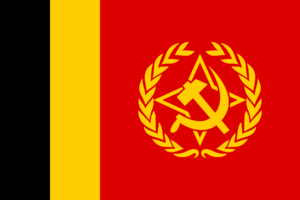Economy of Velaheria
 Flag of Velaheria | |
| Currency | Wran (VW) |
|---|---|
| 1 March — 31 April | |
Trade organisations | None |
| Statistics | |
| GDP | USD 80 billion (PPP, 2020) |
GDP growth | 2.7% (2020) |
GDP per capita | USD 2,720 (PPP, 2020) |
GDP by sector | Services: 30,7% Industry: 42,3% Agriculture: 18,0% |
| 5.6% | |
Population below poverty line | N/A (2020) |
| 0.30 (2020) | |
Labour force | 18 million (2020) |
Labour force by occupation | Services: 32,1% Industry: 40,9% Agriculture: 18,0% |
| Unemployment | 5-7% (2020) |
Main industries | List
|
| External | |
Export goods | List
|
Import goods | List
|
Velaheria has maintained one of the most closed and centralized economies in the wurld since the 1940s. For several decades, it followed the Central pattern of five-year plans with the ultimate goal of achieving self-sufficiency. Extensive communist support allowed Velaheria to rapidly register very high growth rates, However, this has also lead to systematic inefficiencies which are largely visible in the economic production and activities of velaheria.
The State expertises in the production of heavy machinery, metals and minerals which form the backbone of its economy. It also has its fair share of growth through agricultural activities which form a large part of its economy.
Services are a relatively moderate part of the nation, with the average services available being small scaled due to the centralization of policies and the ban on private ownership and existence of large scale private companies inside the nation, though several minor small private organization thrive inside the nation's largest cities, due to a general lack of oversight by the government on their activities.
Sectors of Economy
Fishing
Velaherian fisheries export riverfood, primarily crab, to Stedoria and Fravina.
Crabs, clams and conches from the river waters of Velaheria are popular in Stedoria, possibly because the less salty water improves taste.
Retail
In the early 1990s the official retail sector was mainly state-controlled, under the direction of the Velaherian People's Services Bureau, they ensured to distribute the people the regular day to day consumer goods for their requirement, which was free of any cost, and could be consumed by anyone, despite their wages, though beauracracy made such efforts falter in the early 2000's.
Consumer goods are adequate but of poor quality, with most provided on a ration basis. There are state-run stores and direct factory outlets for the masses, and special shops with luxuries for the elite classes, as well as a chain of hard-currency stores with branches in large cities.
In 2002 and in 2010, private markets were progressively legalized, mostly for food sales, as the state has failed to provide food to the populace on a larger scale, with about 10% of the population facing situations close to malnutrition, though this situation has mostly been handled due the opening of several small food retail stores which, sell food to the people.
As of 2013, urban and farmer markets were held every 10 days, and most urban residents lived within 1 km of a market, which made it easier to acccess those markets and ensured that every person could get access to the basic neccesities of their daily survival.
As of 2014, these malls sold competing brands of goods, for example at least ten different kinds of shampoo are being sold, there were also several types of bicycles, food products and other commodities that were being sold mostly to the elite sections of the society.
In 2019, some independent sources estimated there were 660 government-approved markets employing about 1.6 million people.
Criticism
Corruption
Corruption inside of Velaheria is widespread, this is mainly observed by the fact that even the simplest of actions require's some sort of illegal actions, Corruption is visible in all sections of society, Though the people have largely seemed to have accepted it, partially due to the lack of government's interest to act on such matters.